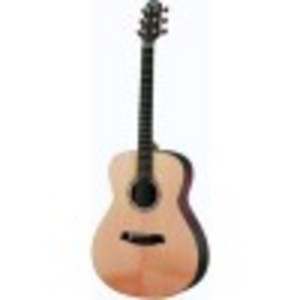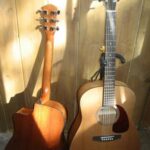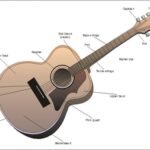After reading an article recently about this guitar in a national magazine devoted to acoustic guitar news, I decided to give one a try – with some trepidation. After all, it is made in China, is very inexpensive, has plastic appointments but was said to be surprisingly good for what it is and possible creating a new direction for inexpensive, decent sounding acoustic guitars in this country. I shopped it online and bought it from a dealer who set it up nicely and delivered it, with a branded gig bag and a Planet Waves humidifier included, for $220.
What I received, frankly astounded me and prompted me to write this review to encourage beginning (and even intermediate) acoustic guitar players to be slow reject an instrument like this one out-of-hand. At the risk of sounding as though I am stooping to reviewers hyperbole, I must confess that I was shocked. This is a LOT of guitar for the money – one that outperforms instruments costing several times as much and is well worth a try. The bottom line price of the instrument can be attributed not only to the use of some plastics and laminates, but also to the fact that it is manufactured in a country where human labor is considerably cheaper than in most Wester (and many other Eastern) countries. This is, however, the review of a guitar – not an essay or commentary on Chinese socio-economic realities or of American purchasing practices as they may or may not reflect their (our) expressed values. This is a LOT of guitar for the money, one that plays richly and easily and is an unarguable bargain for the price.
Construction
To begin, this guitar is what is called a Grand Auditorium style. To compare it with the more commonly sized Dreadnaught acoustic, it’s upper bout (the rounded part of the guitar’s body closest to the neck) is about the same, the waist is a tad narrower and the lower bout (the widest, bottom section of the guitar’s body) is about an inch wider. These seemingly modest adjustments give off an enriched bass response that might otherwise be lost in an instrument this light.
The top is solid Western Red cedar, a wood second only to Sitka spruce in it’s popularity as an acoustic top by most guitar makers. Though listed as being Sapele mahogany, the sides and back are actually laminate versions of that wood – not the solid wood that is generally preferred – but a material better suited to resisting the impact of fluctuating temperatures and humidity. The soundboard bracing, a key structural element of any acoustic guitar, is the Scalloped-X Bracing, the style most preferred by most top-of-the-line guitar makers including both Martin and Guild. The neck material is mahogany and the fretboard is solid rosewood.
There is a two-way adjustable trussrod (the state of the art for adjusting guitar necks for ideal alignment and playability.)The side and back laminated woods are nicely matched and there are no conspicuous flaws in construction, assembly or finish – Walden calls it’s own finish a “Satin Nitrocellulose Lacquer” – essentially a low-gloss, satiny finish. The neck width at the nut (the tuning end of the neck) is a narrow 1 – 11/16″ – the standard width for Martin guitars and narrow enough to be easily played by people with small hands.
Decorative Appointments
Here is where a lot of money has been saved in the manufacture, but the various items now listed do not, in any way, adversely effect the overall performance of the guitar. The binding (the edging around the guitar) is black plastic as is the rosette 2-ring inlay (the decoration around the sound hole). The tuners are non-branded but standard appearing closed die-cast chrome, the bridge is rosewood and – as it’s one elegant feature, the company logo has been placed in pearl inlay on the headstock. It is also embossed ( a rather cheapening look) on the pick guard. The string holing pins are plain black – You won’t find any Mother of Pearl dots or inlay here.
Playability, Feel and Sound
Properly set up, the action is surprisingly smooth and easy. Coupled with the narrow neck, this guitar is MUCH easier to play than any other instrument in it’s general price range I have played. The guitar feels quite light – a function of the materials used in construction BUT the tinny, bassless sound one would expect from such a light piece simply does not materialize. The GA style increases the bass response to a degree that it’s sound is simply not at all commensurate with what would seem appropriate expectations. It is MUCH better than that!
If you’re in the market for an inexpensive 6-steel string acoustic guitar (they do make other models as well, including 12-strings), you’ll be hard pressed to find better value, sound or overall experience for your money.





